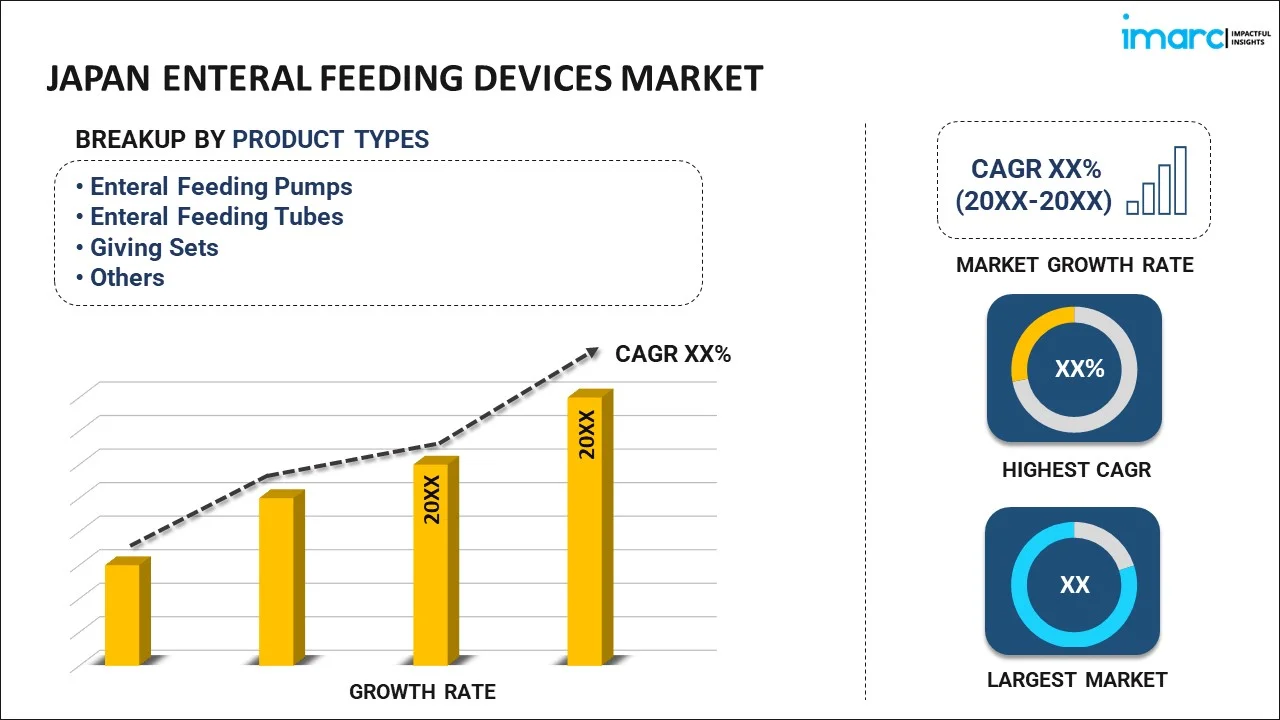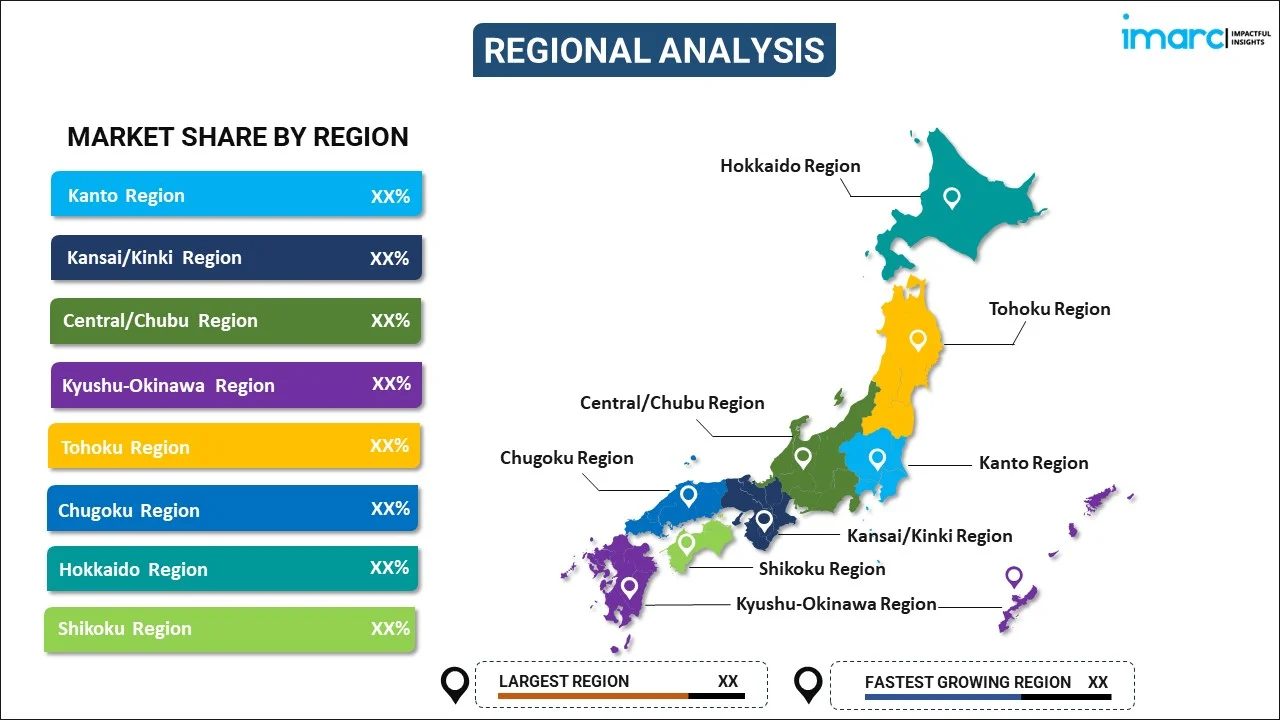
Japan Enteral Feeding Devices Market Report by Product Type (Enteral Feeding Pumps, Enteral Feeding Tubes, Giving Sets, Enteral Syringes, Consumables, and Others), Age Group (Adults, Pediatrics), Application (Oncology, Gastroenterology, Neurology, Diabetes, Hypermetabolism, and Others), End User (Hospitals, Ambulatory Surgery Centers, and Others), and Region 2025-2033
Market Overview:
Japan enteral feeding devices market size reached USD 124.8 Million in 2024. Looking forward, IMARC Group expects the market to reach USD 185.5 Million by 2033, exhibiting a growth rate (CAGR) of 4.1% during 2025-2033. The growing geriatric population in Japan, leading to a higher prevalence of chronic illnesses and conditions that require enteral nutrition, is driving the market.
|
Report Attribute
|
Key Statistics
|
|---|---|
|
Base Year
|
2024 |
|
Forecast Years
|
2025-2033
|
|
Historical Years
|
2019-2024
|
| Market Size in 2024 | USD 124.8 Million |
| Market Forecast in 2033 | USD 185.5 Million |
| Market Growth Rate (2025-2033) | 4.1% |
Enteral feeding devices are crucial medical tools used to deliver essential nutrients and medications directly into a patient's gastrointestinal tract when they are unable to consume food orally. These devices play a vital role in the healthcare industry, serving a diverse range of patients, from premature infants to the elderly and individuals with various medical conditions. One common type of enteral feeding device is the feeding tube, which can be inserted through the nose or mouth or directly into the stomach or intestines through a surgical procedure. These tubes come in different sizes and materials to suit the patient's needs, ensuring a safe and comfortable delivery of nutrition. Enteral feeding devices are used in hospitals, nursing homes, and home healthcare settings, enabling healthcare professionals to provide tailored nutrition and treatment plans. They help patients who may have difficulty swallowing, suffer from gastrointestinal disorders, or are recovering from surgeries and illnesses. By facilitating precise nutrient delivery, these devices support patient recovery, promote healing, and improve their overall quality of life.
Japan Enteral Feeding Devices Market Trends:
Several factors are driving the growth of the enteral feeding devices market in Japan. Firstly, the rising prevalence of chronic diseases, such as cancer, gastrointestinal disorders, and neurological conditions, is a significant driver. These conditions often necessitate long-term enteral nutrition support, leading to increased demand for feeding devices. Moreover, the aging population is contributing to market expansion, as elderly individuals are more prone to conditions requiring enteral feeding. Furthermore, technological advancements in enteral feeding devices are playing a pivotal role in market growth. Innovations such as smart pumps and wireless connectivity have improved the accuracy and convenience of administering enteral nutrition, making it more appealing for healthcare professionals and patients alike. In addition to this, the increasing awareness about the benefits of enteral nutrition over parenteral nutrition, such as reduced infection risks and cost-effectiveness, is expected to drive the enteral feeding devices market in Japan during the forecast period.
Japan Enteral Feeding Devices Market Segmentation:
IMARC Group provides an analysis of the key trends in each segment of the market, along with forecasts at the country level for 2025-2033. Our report has categorized the market based on product type, age group, application, and end user.
Product Type Insights:

- Enteral Feeding Pumps
- Enteral Feeding Tubes
- Giving Sets
- Enteral Syringes
- Consumables
- Others
The report has provided a detailed breakup and analysis of the market based on the product type. This includes enteral feeding pumps, enteral feeding tubes, giving sets, enteral syringes, consumables, and others.
Age Group Insights:
- Adults
- Pediatrics
A detailed breakup and analysis of the market based on the age group have also been provided in the report. This includes adults and pediatrics.
Application Insights:
- Oncology
- Gastroenterology
- Neurology
- Diabetes
- Hypermetabolism
- Others
The report has provided a detailed breakup and analysis of the market based on the application. This includes oncology, gastroenterology, neurology, diabetes, hypermetabolism, and others.
End User Insights:
- Hospitals
- Ambulatory Surgery Centers
- Others
A detailed breakup and analysis of the market based on the end user have also been provided in the report. This includes hospitals, ambulatory surgery centers, and others.
Regional Insights:

- Kanto Region
- Kansai/Kinki Region
- Central/ Chubu Region
- Kyushu-Okinawa Region
- Tohoku Region
- Chugoku Region
- Hokkaido Region
- Shikoku Region
The report has also provided a comprehensive analysis of all the major regional markets, which include Kanto Region, Kansai/Kinki Region, Central/ Chubu Region, Kyushu-Okinawa Region, Tohoku Region, Chugoku Region, Hokkaido Region, and Shikoku Region.
Competitive Landscape:
The market research report has also provided a comprehensive analysis of the competitive landscape. Competitive analysis such as market structure, key player positioning, top winning strategies, competitive dashboard, and company evaluation quadrant has been covered in the report. Also, detailed profiles of all major companies have been provided.
Japan Enteral Feeding Devices Market Report Coverage:
| Report Features | Details |
|---|---|
| Base Year of the Analysis | 2024 |
| Historical Period | 2019-2024 |
| Forecast Period | 2025-2033 |
| Units | Million USD |
| Scope of the Report | Exploration of Historical and Forecast Trends, Industry Catalysts and Challenges, Segment-Wise Historical and Predictive Market Assessment:
|
| Product Types Covered | Enteral Feeding Pumps, Enteral Feeding Tubes, Giving Sets, Enteral Syringes, Consumables, Others |
| Age Groups Covered | Adults, Pediatrics |
| Applications Covered | Oncology, Gastroenterology, Neurology, Diabetes, Hypermetabolism, Others |
| End Users Covered | Hospitals, Ambulatory Surgery Centers, Others |
| Regions Covered | Kanto Region, Kansai/Kinki Region, Central/ Chubu Region, Kyushu-Okinawa Region, Tohoku Region, Chugoku Region, Hokkaido Region, Shikoku Region |
| Customization Scope | 10% Free Customization |
| Post-Sale Analyst Support | 10-12 Weeks |
| Delivery Format | PDF and Excel through Email (We can also provide the editable version of the report in PPT/Word format on special request) |
Key Questions Answered in This Report:
- How has the Japan enteral feeding devices market performed so far and how will it perform in the coming years?
- What has been the impact of COVID-19 on the Japan enteral feeding devices market?
- What is the breakup of the Japan enteral feeding devices market on the basis of product type?
- What is the breakup of the Japan enteral feeding devices market on the basis of age group?
- What is the breakup of the Japan enteral feeding devices market on the basis of application?
- What is the breakup of the Japan enteral feeding devices market on the basis of end user?
- What are the various stages in the value chain of the Japan enteral feeding devices market?
- What are the key driving factors and challenges in the Japan enteral feeding devices?
- What is the structure of the Japan enteral feeding devices market and who are the key players?
- What is the degree of competition in the Japan enteral feeding devices market?
Key Benefits for Stakeholders:
- IMARC’s industry report offers a comprehensive quantitative analysis of various market segments, historical and current market trends, market forecasts, and dynamics of the Japan enteral feeding devices market from 2019-2033.
- The research report provides the latest information on the market drivers, challenges, and opportunities in the Japan enteral feeding devices market.
- Porter's five forces analysis assist stakeholders in assessing the impact of new entrants, competitive rivalry, supplier power, buyer power, and the threat of substitution. It helps stakeholders to analyze the level of competition within the Japan enteral feeding devices industry and its attractiveness.
- Competitive landscape allows stakeholders to understand their competitive environment and provides an insight into the current positions of key players in the market.
Need more help?
- Speak to our experienced analysts for insights on the current market scenarios.
- Include additional segments and countries to customize the report as per your requirement.
- Gain an unparalleled competitive advantage in your domain by understanding how to utilize the report and positively impacting your operations and revenue.
- For further assistance, please connect with our analysts.
 Inquire Before Buying
Inquire Before Buying
 Speak to an Analyst
Speak to an Analyst
 Request Brochure
Request Brochure
 Request Customization
Request Customization




.webp)




.webp)












